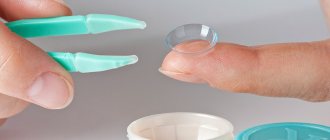Today, contact optics is considered the optimal means of correcting visual pathologies. Innovative technologies and materials make lenses comfortable to use. They do not hinder movement and are not felt on the eyes. But under certain circumstances, optical products can leave negative consequences.
There are many reasons and factors for the occurrence of discomfort during the use of contact lenses, let's consider the main ones, as well as the consequences and eye diseases that may appear in the process.
What can be the consequences of wearing lenses?
The consequences of long-term wearing of contact lenses can be either easily corrected or very severe, causing serious eye diseases. Often the situation is complicated by the fact that at the initial stages it is difficult to determine the true cause of discomfort, which may lie in eye pathology and the characteristics of the selected lenses: their material, type, gas permeability and moisture content. The most common consequences of using contact optics include:
- Swelling of the cornea;
- Excessive deposition of protein formations on the surface of the lenses;
- Conjunctivitis;
- Dry eye syndrome;
- Proliferation of blood vessels;
- Keratitis;
- Corneal ulcer;
- Allergic reactions.
Let's look at each of them in more detail.
Discomfort that cannot be tolerated
In all developed countries, contact lenses are a common method of vision correction. The boom in lenses in Russia began about 5 years ago, today approximately 3-4% of the country's adult population use them. The most popular have become lenses made of silicone hydrogel material, which to the greatest extent allow oxygen to penetrate the tissues of the eye. However, scientists have not yet invented lenses that are absolutely safe for the eye.
Therefore, ophthalmologists believe that the risk of complications when wearing any contact lenses, even the thinnest, elastic, oxygen-permeable ones, increases over time, in other words, the risk of complications is higher in a person who wears lenses daily for five years compared to a person who which has less than a year of wearing experience.
The first option to solve this problem is to stop wearing contact lenses, undergo laser vision correction, or switch to glasses, since sooner or later the compensatory capabilities of the cornea dry up with regular contact with a foreign body. And then changes begin to develop in the cell membranes of the cornea and conjunctiva, which, according to various experts, in approximately 3-20% of cases take on the character of pathological processes that require treatment and are classified as complications, and lead to intolerance to contact lenses.
One of the complications may be corneal erosion, which is usually caused by microtrauma during lens insertion and removal. Corneal edema often develops. Neovascularization (vessel growth) of the cornea forms when wearing lenses for a long time, or in situations where the wearing period of lenses is exceeded, as well as when wearing lenses with low oxygen permeability. Dry eye syndrome develops due to the thinning of the tear film in long-term contact lens wearers. Another common complication leading to intolerance to contact lenses among some of their users is follicular conjunctivitis. One of the reasons for its occurrence is wearing incorrectly selected lenses.
Fortunately, in most cases these complications do not develop as an acute process. All of them, still at the “pre-illness” stage, that is, still reversible disorders, warn the lens wearer with a characteristic signal - a feeling of discomfort in the eyes when wearing contact lenses, indicating that something is wrong with the cornea and conjunctiva.
And at this stage, when serious eye treatment is not yet required, you can choose the second solution, thanks to which you will not have to give up lenses and wear them safely and comfortably for many years to come.
In ophthalmological practice, there are special means for regeneration (restoration) and preservation of the functions of cells of the cornea and conjunctiva, which prevent the development of complications at the earliest signs of damage to the tissues of the ocular surface. Thanks to regular course use of such drugs, it is possible to ensure effective prevention of all those eye complications that were mentioned above.
But you need to start using these remedies at the first sign of eye discomfort, this will help prevent the development of more serious damage. The main sign that the drug has worked will be the disappearance of discomfort. Without appropriate treatment, the condition of the superficial structures of the eye will only worsen.
In ophthalmology, in such cases, special eye gels are used to restore the corneal epithelium and regularly protect the eyes when wearing contact lenses. The gel structure prolongs the contact of the active substance with the surface of the eye and alleviates the feeling of discomfort.
The composition of such gels includes active substances that have a healing effect, so-called protectors of the cornea and conjunctiva, which prevent the development of erosions, edema, keratitis and conjunctivitis that occur due to wearing contact lenses. As such, ophthalmologists prefer to prescribe Korneregel, which contains dexpanthenol, which has regenerating and anti-inflammatory effects, as well as a moisturizing component that eliminates discomfort.
Korneregel is an eye gel that heals the cornea and conjunctiva in contact lens wearers, preventing a decrease in the quality of vision that can occur due to the development of complications, has an anti-inflammatory effect, eliminating pain, swelling and redness, and also contains carbomer, which moisturizes the surface of the eye, relieving discomfort . It is important to remember that when using Korneregel, contact lenses should be removed and put on only 15 minutes after using the drug. To prevent the development of complications of contact vision correction, Korneregel should be used in courses of 1 month every six months and instilled at night after removing the lenses.
Corneal edema
A deviation such as corneal edema most often occurs due to an insufficient amount of oxygen supplied to the visual organs, which may be directly related to incorrectly selected curvature of the optical product (an individual parameter for each patient), their nighttime use during sleep, overwear or material characteristics.
The main signs of corneal edema are: blurred image, “rainbow” when looking at bright light, pain during prolonged use of lenses, redness.
This consequence can be eliminated in a few days if you consult a specialist in a timely manner.
What are the dangers of wearing contact lenses?
Of course, there is a great temptation to put on lenses and immediately see everything clearly. At the same time, friends, you need to clearly understand how contact lenses can be dangerous in general.
The worst thing about lenses is that they absolutely do not allow you to relax your vision during the day. You can't just take them off like glasses and do simple exercises to relieve eye fatigue and prevent the progression of myopia.
The fact is that with myopia, some extraocular muscles are in a spasmodic state, they experience constant chronic overstrain.
The amplitude of muscle work is significantly reduced, and the eyeball has a so-called “myopic” shape - it is elongated along the optical axis of the eye.
Shape of the eyeball with normal vision and myopia
By putting on lenses, we seem to begin to see well, but at the same time, muscle strain remains and over time, quite naturally, will only intensify.
Glasses allow you to take them off and do basic relaxation exercises, relieving excess spasm of the extraocular muscles.
This helps protect the eyes from the accumulation of additional stress and restore the normal process of accommodation.
As for the direct immediate risks that you are exposed to when wearing lenses:
At the first place
Among them are infections that are quite often introduced.
The second stage
involves long-term wearing of lenses and associated hypoxic changes in the cornea. Even the most oxygen-permeable soft lenses have strict restrictions on how long they can be worn.
Most people who wear contact lenses usually put them on in the morning at 8 o'clock and take them off late at night.
As a result of such prolonged wearing, there is a lack of oxygen access to the cornea, which causes the growth of blood vessels from the limbal (opaque) zone and their penetration into the cornea.
Normally, the cornea has no blood vessels and receives nutrition osmotically, so these changes are irreversible.
Always carefully read the instructions, what is the maximum period of wearing certain lenses. Any lenses block oxygen access to the eye and disrupt osmotic processes in the cornea.
And now in more detail
(there will be no scary pictures)
Corneal edema
In some cases, when wearing contact lenses for a long time, corneal edema may occur. This occurs due to improperly shaped lenses, as well as sleeping in lenses. Symptoms: blurred image, iridescent streaks around light sources, redness of the eyes.
Corneal erosion
This eye damage can occur as a result of a disruption in the exchange of tear fluid. As a rule, this is the result of prolonged wearing of lenses, or an individual reaction to them.
Inaccurate selection of lenses can provoke allergic reactions during use. Not everyone will benefit from the same lens material. The main symptom is blurred vision. At the initial stage, this disorder is easy to treat, but it absolutely cannot be neglected and if these symptoms appear, you must contact a specialist as soon as possible.
Giant papillary conjunctivitis
The advent of oxygen-permeable lenses for daily wear has significantly reduced the likelihood of developing this disorder, but it still occurs. In this case, a seal appears on the upper eyelid and mucus begins to accumulate in the eye. Timely treatment involves very frequent, unpleasant rinsing. In the worst case, this disorder can cause deep keratitis.
Keratitis
They are corneal ulcers with acute pain and noticeable photophobia. Acanthamoeba keratitis, caused by microorganisms living in water, is especially dangerous. Lenses create ideal breeding conditions for them. If you miss the onset of this type of keratitis (one of the most likely to occur for lens wearers), then persistent corneal opacities are highly likely to occur.
Acanthamoeba keratitis is the most dangerous because if treatment is not started in time, you can lose not only your vision, but also your eye.
Thinning of the cornea
Even with proper lens wear, corneal thinning and even corneal ulceration can often develop after 3-5 years.
A corneal ulcer can occur as a complication of any infection of the eye when it thins. The infectious form is usually accompanied by severe pain and suppuration. The sterile form of the ulcer occurs without pain.
Formation of new vessels
The patient does not feel it at first, but upon diagnosis, the first changes are immediately visible. Later, blood vessels begin to grow between Bowman's membrane and the epithelium, which begins to seriously affect vision.
Conjunctival fissures
When wearing contact lenses, the cornea experiences daily stress; microtraumas may appear on its surface, accompanied by pain symptoms, the sensation of a foreign body in the eye, lacrimation and redness of the conjunctiva.
Several years ago, another negative consequence of wearing lenses was identified - conjunctival fissure. Cracks most often occur when wearing lenses made of silicone hydrogel. They occur where the edge of the lens touches the conjunctiva.
If you wear contact lenses, you need to remember 3 rules:
1.
Be sure to wash your hands when putting on and taking off your lenses. Even if you need to correct something, wash your hands well. If it is not possible to do the manipulations with clean hands, it is better not to touch anything, or wear glasses.
2.
If you experience dry eyes, immediately stop wearing lenses for one to two weeks until signs of corneal edema subside.
3.
Wear quality glasses made directly for you after a comprehensive examination. Do not buy ready-made glasses from an optician, after taking measurements only with a refractometer.
Perfect option:
Start practicing natural vision restoration; students at the Academy of Vision have been doing this for more than 10 years in 10 countries.
Depending on the degree of visual impairment and the amount of effort applied, they manage to restore vision by 0.25 to 1 diopter per month.
Remember: this is the only option in which
the natural physiological shape of the eyeball is restored, the functioning of the eye muscles is restored, and all risks associated with both the use of lenses and the risks of further deterioration of vision disappear.
Read about further risks you expose yourself to if you have visual impairments: What happens if you have poor vision
What is natural vision restoration based on?
The natural restoration of normal eye refraction is based on two elements: daily exercises for 2-3 months (at least 30 minutes) and healthy visual habits.
The task comes down to balancing the work of the eye muscles, as well as relieving spasms and congestion, to restore the normal length of the optical axis of the eyeball. In the case of astigmatism, additional work is also required to normalize the curvature of the cornea.
During classes, with moderate and severe refractive error, weaker glasses are worn. At the initial level of violations, glasses are worn only when it is really necessary, for example, when driving, crossing the street or working with documents.
This approach allows you to quickly relieve tension from the eye muscles, which is the main cause of refractive errors.
Attention: without regular exercise and the formation of a set of healthy visual habits, reducing the diopters of corrective glasses is not allowed
, even if you do any eye exercises yourself! This will make you squint even more and the tension in your eyes will only increase.
Expert: Lila Ungvari, an ophthalmologist with more than 25 years of experience in European ophthalmological centers, 10 of which were involved in the certification of airline flight personnel. European instructor of natural vision restoration.
Source: https://zen.yandex.ru/media/id/5bf4599c8ecad300aab81339/5c5babd83002ff00ad61111a
Formation of protein deposits
A very common manifestation, which is quite natural when wearing optical products with a long period of use. The fact is that the proteins, lipids and calcium that make up the tear fluid come into direct contact with the surface of the lenses.
When the components of tear fluid accumulate on the surface of the lens, a non-uniform film appears, it can distort vision and cause irritation of the visual organs, itching and redness.
If the user does not follow the rules of hygiene and lens care, infectious eye diseases may occur. That is why experts strongly recommend daily cleaning of optical products with a multi-purpose solution that contains special enzymes to eliminate such deposits.
If the problem of lipid and protein formations occurs too often, it is better to use contact optics made from materials containing Comfilcon A or Netrafilcon A, which make the surface of the lenses more resistant to the accumulation of proteins and lipids. It is also worth considering daily replacement products that do not require maintenance. At the end of the day, you dispose of your used pair and put on a new pair in the morning. In a short period of wearing, such formations do not have time to appear on the surface of the product, so any danger is excluded.
It is very important to understand that protein deposits are a potential cause of various infections, and their rough surface can cause microtrauma to the cornea.
Possible diseases if worn incorrectly
It is very important to use your contact lenses correctly and visit a doctor at least once every six months to monitor your eye health, since with contact vision correction, changes in the cornea may begin to be asymptomatic.
You should also consult a doctor if there is even a slight suspicion of a serious deviation. Contact lenses themselves are not harmful, but using them incorrectly can cause harm. So what kind of troubles can be avoided by strictly adhering to the rules and routine of wearing lenses and following hygiene requirements?
Swelling of the cornea, which can occur as a result of insufficient oxygen supply to it. This can happen as a result of wearing lenses while sleeping at night, as well as poorly fitting lenses.
Microbial keratitis
Microbial keratitis is a disease with very complex consequences, including loss of vision. Normally, the human eye is designed so that the surface of the eye is cleaned by the eyelids when blinking, and the tear fluid washes away debris and pathogenic microbes. But when wearing lenses for up to 30 days without removing them, the danger of microbial keratitis becomes very real. Staphylococcus aureus can develop in the eye, which is the most common cause of microbial keratitis.
Corneal ulcer
If the cornea has been injured, and the norms for wearing lenses and caring for the eyes and the lenses themselves are violated, then symptoms such as pain, purulent discharge, and a hole may appear in the upper layer of the cornea. This disease requires the most urgent treatment.
Corneal ulcer
Protein deposits
Protein deposits are one of the most harmless consequences of wearing lenses, almost inevitable. The salts contained in the tear film, fat molecules and protein accumulate on the lenses, making it uneven and rough over time. Although the accumulations are so microscopic that they cannot be seen with the naked eye, they reduce the life of the lenses and can cause infection. Most likely, your ophthalmologist will suggest that you switch to using a different cleaning solution, with special enzymes that dissolve protein deposits.
It must be remembered that protein deposits on the surface of lenses are the most common reason why bacteria can penetrate the cornea through microscratches caused by such a lens.
Allergy
Eye allergies are also a common problem for patients wearing lenses. If a person has an allergic reaction to the materials from which the lens is made, to the solution that the patient uses to care for the lenses, as well as to those elements that accumulate on the lenses over time, then with prolonged contact with the eye this often causes an allergy. It can, in turn, cause allergic conjunctivitis. Such problems are solved by replacing the lenses with others, from other materials, from another manufacturer.
Manifestation of allergies to lenses
Red eye syndrome
Red eye syndrome is simply a manifestation of some abnormality that causes the redness of the eye, either it is a physical irritation, or an infection, or of another origin. But regardless of the nature of the phenomenon, it is very important to differentiate simple redness from minor problems from allergies and infectious diseases.
Conjunctivitis
This eye disease from lenses can occur due to the presence of allergens in the composition of care products, as well as accumulated protein formations and other contaminants (for example, cosmetic residues). Conjunctivitis appears as a small bulge at the top of the eyelid. Signs of pathology: itching, lacrimation, irritation, sensation of a foreign object in the eye.
To eliminate capillary conjunctivitis, it is recommended to avoid the use of contact lenses until the problem is completely resolved. The specialist will help you select other optical products based on the material, prescribe medications that prevent the development of mast cells, and drops that eliminate discomfort.
Part of the problem with wearing contact lenses may be inside you.
Of course, blaming all the discomfort on your lens care products is not the wisest decision you can make in this life: in reality, there are practically no situations where all the blame falls solely on one thing. So it is in contact vision correction - part of the problem may lie in yourself, in how you use the solutions. Recently, the ideology of skipping mechanical cleaning of the lens with your fingers (products labeled “No Rub”) has become widespread. Manufacturers put this inscription in large letters on the packaging, hoping to increase sales of solutions through this, since patients want simplified lens care. True, many patients even before the advent of such solutions skipped this stage of the care procedure, and new solutions only provide even more reasons to neglect it.
Unfortunately, patients rarely read instructions. But carrying out a passive, without mechanical cleaning, lens care procedure provides the desired effect only when carried out in accordance with the company’s instructions - it involves rinsing the front and back surfaces of the lens for a certain time (several seconds) with a solution. Thrifty patients quickly estimate how much solution they will have to pour out in, say, ten seconds and how long the package will last for them... As a result, most of them mean the following by “No Rub”: remove the lens, pour the solution into the container and put the lens in him. That's all... It is clear that in this case complications are just around the corner. After all, inadequate cleaning of the lens leads to the growth of deposits, which can also cause discomfort and the desire to quickly remove the contact lens. And besides, it is no secret that many patients wear lenses much longer than the time recommended by the manufacturer.
If you want to comfortably wear soft contact lenses for many years, then you need to use the solution that was prescribed to you, and not change it at will. You must be able to recognize the first symptoms of an allergy to the solution (redness of the eyes, mild pain) and understand that when they appear, you should not endure it, but go to the doctor for an appointment. Redness and discomfort are not normal and are signs of a brewing problem. Suppliers of private label solutions change their chemical composition from time to time, which can also affect comfort.
Dry eye syndrome
Very often, users who wear contact lenses for a long time develop dry eye syndrome or, as experts call it, keratoconjunctivitis. As a rule, the disease occurs due to prolonged and intense work at the computer, being in a room with dry air and a deficiency in the production of tear fluid by the visual system.
To eliminate discomfort, doctors prescribe medications containing the same components as human tears (for example, hyaluronic acid).
On the modern optics market, there are special lenses that eliminate the symptoms of the disease, which are created specifically for sensitive eyes and are able to retain moisture on the surface for as long as possible. It is also advisable for people with dry eye syndrome to use additional moisturizing drops and gels.
Consequences of wearing contact lenses. Delivery of contact lenses and glasses in Moscow and Russia
Today, contact optics is considered the optimal means of correcting visual pathologies. Innovative technologies and materials make lenses comfortable to use. They do not hinder movement and are not felt on the eyes. But under certain circumstances, optical products can leave negative consequences.
There are many reasons and factors for the occurrence of discomfort during the use of contact lenses, let's consider the main ones, as well as the consequences and eye diseases that may appear in the process.
Causes of discomfort when using lenses
Under normal conditions, using contact optics should not cause any discomfort. However, if the user still experiences discomfort, the reasons for this may be:
- Eye diseases: dystrophy of the cornea, conjunctiva, pathologies of the lacrimal canal, erosion, chronic diseases of the eyelids.
- General pathologies of the body as a whole: vitamin deficiency, diabetes mellitus.
- Taking certain medications. As a result, abundant protein and lipid formations may occur on the surface of optical products and a decrease in the production of tear fluid.
- Low level of personal hygiene and unfavorable environmental conditions: air pollution and dryness, the presence of allergens, climatic conditions.
- Failure to comply with the planned replacement periods for wearing lenses and using them in a long-term and extended mode, while they are intended exclusively for daytime use.
- Selecting contact optics with low air permeability and moisture content, which affect the proper functioning of the visual system.
- The use of damaged eye lenses, as well as their improper fit.
- Toxic and allergic effects of the components that are part of the multidisciplinary care solution.
- Failure to follow the ophthalmologist's recommendations for lens care.
It is important to understand that compliance with the scheduled replacement of lenses and adherence to simple and mandatory rules for caring for them will provide you not only with comfort, but also with healthy vision.
Otherwise, contact lenses may cause the user the following symptoms:
- Pain;
- Tingling;
- Itching and burning;
- Irritation;
- Feelings of a foreign body in the eye;
- Profuse lacrimation;
- Photophobia;
- Decreased visual acuity, blurry picture;
- Rainbow circles around objects;
- Discharge from the eyes.
If at least one of the above-described symptoms occurs, the optical products must be immediately removed and their surface checked for contamination (dust, cosmetic residues, etc.) or damage. In the first case, the user needs to clean them with a special solution, and in the second, it is strictly not recommended to use the lenses; it is worth replacing them with a new pair.
If, after the procedures performed, discomfort persists when putting on lenses, you need to contact a specialist for help, he will help identify the actual cause, conduct a comprehensive diagnosis of the visual system and help solve the problem.
What can be the consequences of wearing lenses?
The consequences of long-term wearing of contact lenses can be either easily corrected or very severe, causing serious eye diseases.
Often the situation is complicated by the fact that at the initial stages it is difficult to determine the true cause of discomfort, which may lie in eye pathology and the characteristics of the selected lenses: their material, type, gas permeability and moisture content. The most common consequences of using contact optics include:
- Swelling of the cornea;
- Excessive deposition of protein formations on the surface of the lenses;
- Conjunctivitis;
- Dry eye syndrome;
- Proliferation of blood vessels;
- Keratitis;
- Corneal ulcer;
- Allergic reactions.
Let's look at each of them in more detail.
Formation of protein deposits
A very common manifestation, which is quite natural when wearing optical products with a long period of use. The fact is that the proteins, lipids and calcium that make up the tear fluid come into direct contact with the surface of the lenses.
When the components of tear fluid accumulate on the surface of the lens, a non-uniform film appears, it can distort vision and cause irritation of the visual organs, itching and redness.
If the user does not follow the rules of hygiene and lens care, infectious eye diseases may occur. That is why experts strongly recommend daily cleaning of optical products with a multi-purpose solution that contains special enzymes to eliminate such deposits.
If the problem of lipid and protein formations occurs too often, it is better to use contact optics made from materials containing Comfilcon A or Netrafilcon A, which make the surface of the lenses more resistant to the accumulation of proteins and lipids.
It is also worth considering daily replacement products that do not require maintenance. At the end of the day, you dispose of your used pair and put on a new pair in the morning.
In a short period of wearing, such formations do not have time to appear on the surface of the product, so any danger is excluded.
It is very important to understand that protein deposits are a potential cause of various infections, and their rough surface can cause microtrauma to the cornea.
Dry eye syndrome
Very often, users who wear contact lenses for a long time develop dry eye syndrome or, as experts call it, keratoconjunctivitis. As a rule, the disease occurs due to prolonged and intense work at the computer, being in a room with dry air and a deficiency in the production of tear fluid by the visual system.
To eliminate discomfort, doctors prescribe medications containing the same components as human tears (for example, hyaluronic acid).
On the modern optics market, there are special lenses that eliminate the symptoms of the disease, which are created specifically for sensitive eyes and are able to retain moisture on the surface for as long as possible. It is also advisable for people with dry eye syndrome to use additional moisturizing drops and gels.
Vessel proliferation on the cornea
Due to improperly selected soft contact lenses, proliferation of blood vessels on the cornea of the visual organs can occur. The reason for this is the insufficient amount of oxygen supplied to the cornea.
This consequence is often associated with the use of contact optics with daytime mode during sleep.
If the user needs to sleep in optical products, it is worth choosing night lenses, that is, with a flexible or prolonged mode of use.
Conclusion
Almost all the negative consequences associated with wearing contact optics arise due to non-compliance with the rules of hygiene and care, as well as neglect of scheduled visits to the ophthalmologist, which must be done at least once a year. If you experience at least one of the symptoms described above, you should immediately seek help from a doctor and take appropriate measures.
Source: https://www.ochkov.net/informaciya/stati/posledstviya-nosheniya-kontaktnyh-linz.htm
Vessel proliferation on the cornea
Due to improperly selected soft contact lenses, proliferation of blood vessels on the cornea of the visual organs can occur. The reason for this is the insufficient amount of oxygen supplied to the cornea. This consequence is often associated with the use of contact optics with daytime mode during sleep. If the user needs to sleep in optical products, it is worth choosing night lenses, that is, with a flexible or prolonged mode of use.
Consequences of hypoxic damage to the cornea when wearing lenses
Hypoxic changes occur only when wearing hydrogel contact lenses, in which the oxygen transmittance coefficient Dk/t is less than 100, if the lens wearing regimen is not followed, or if lenses are worn around the clock, more than 8-10 hours a day. Hypoxia is manifested by redness of the eyes after and also during wearing lenses.
The fact is that the cornea (cornea of the eye), on the surface of which the contact lens is placed, does not have its own vessels, it is transparent, shiny, and moist in order to ensure the unhindered passage of light rays into the eye. The surface of the cornea consists of a unique epithelium capable of rapid regeneration, which helps quickly restore the surface of the cornea when the surface epithelium is damaged.
Hypoxia due to tight fitting lenses
The cornea receives nutrition from the vessels of the limbal zone. The limbal zone is a vascular ring that is located at the border of the sclera and cornea. That is why it is important that the edge of the contact lens does not put pressure on this area, which happens when the contact lens is tightly fitted. A contact lens with a tight fit can cause hypoxic damage to the cornea of the eyes even if its oxygen transmittance coefficient is more than 100. Only an ophthalmologist can evaluate the correct fit of a contact lens.
Another source of nutrition for the cornea is tears. The tear film constantly washes the cornea, on which the contact lens is located, and delivers the nutrients and oxygen necessary for its functioning.
Eye hypoxia while sleeping in lenses
In addition to the above, the cornea receives oxygen from the air. Therefore, even without a contact lens during sleep, with the eyelids closed, the cornea experiences a state of physiological hypoxia. But thanks to the good compensatory capabilities of the surface epithelium of the cornea, microdamages resulting from physiological hypoxia are quickly restored.
But if you do not remove contact lenses while sleeping, then hypoxic damage to the cornea of the eyes will be much greater, the compensatory capabilities of the surface epithelium may not be enough and this will lead to complications associated with incorrect wearing of contact lenses.
What happens to the surface of the cornea when wearing hydrogel contact lenses during the day? If the contact lens is selected correctly, has a good fit, does not put pressure on the limbal zone, but has an oxygen transmittance coefficient Dk/t below 100, then due to the limited supply of oxygen to the cornea, even with daytime lens wear, sooner or later hypoxic damage to the cornea occurs.
Consequences of corneal hypoxia
At the first stage, when the volume of required oxygen is limited, corneal epitheliopathy occurs. Corneal epitheliopathy can be seen during examination at a slit lamp, after staining the cornea with a special dye.
Visible manifestations of corneal hypoxia are the appearance of vessels growing into the transparent cornea from the limbal zone.
At the next stage of hypoxia, corneal erosions appear and, as a rule, an infection occurs, since an insufficient amount of oxygen is a good environment for the proliferation of bacteria.
At this stage, as a rule, they consult a doctor, since wearing contact lenses is no longer possible.
After treatment, to prevent reoccurrence of erosion, it is recommended to wear only silicone hydrogel lenses with a high Dk/t index, for example Air Optix Night and Day or Biofinity contact lenses; only daytime wearing of lenses is allowed.
Microbial keratitis
This complication is one of the most dangerous and can lead to complete loss of visual ability. Despite the fact that the visual apparatus is designed in such a way that it independently prevents infection by washing the cornea with tear fluid, obsolete cells die off during its functioning and can remain on the surface of the lenses.
The occurrence of microbial keratitis can occur in people who continuously wear night lenses; the consequences are the appearance of microorganisms such as staphylococcus or Pseudomonas aeruginosa. Patients experience profuse lacrimation, burning, photophobia, and purulent discharge.
Corneal ulcer
The disease is often infectious in nature and is accompanied by severe pain, discharge of purulent formations, and lacrimation.
An ulcer can appear if hygiene rules are not followed, lenses are worn for longer than the period specified by the manufacturer, and the cornea is damaged.
Sometimes a person even has a hole in the affected area. The rate of disease progression depends on the type of microorganisms that appear in the visual system. There is also a sterile manifestation of a corneal ulcer; it is mild and without pain symptoms; as a rule, the patient is not aware of its existence in the early stages of development.
Corneal hypoxia
The cornea of the eye receives oxygen from tear fluid, so any contact lenses to a certain extent disrupt the penetration of oxygen and lead to hypoxia. A state of acute hypoxia can occur if the patient forgets to remove lenses on time or leaves lenses that are not intended for long-term wear at night. Mild cases are manifested by corneal edema, a feeling of fog in the eyes, and blurred vision. In more severe cases, the death of corneal epithelial cells and their exfoliation develop. Visual acuity decreases, photophobia develops, and a feeling of discomfort appears.
With prolonged wearing of contact lenses, and even more so in the case of constant non-compliance with the wearing regime, the formation of microcysts is possible (in the depths of the epithelium, dead cells form microcysts and then migrate outward (and the germination of vessels into the corneal tissue - neovascularization. If new vessels are formed exclusively in the limbus area, vision is not impaired and there are no symptoms. However, when the vessels grow from the central area, vision can be significantly impaired. In order to prevent the progression of neovascularization, it is recommended to select thinner lenses and/or with better oxygen permeability.
Allergy
Allergic eye reactions can occur to the material from which contact optics are made, or to components contained in lens care products.
If allergic reactions occur, ophthalmologists recommend either choosing other lenses or replacing the solution with a hypoallergenic one, without adding preservatives.
Formations on the surface of optical products can also become strong allergens; subsequently, such an allergy develops into conjunctivitis, accompanied by itching, photophobia, corneal edema, and lacrimation.











